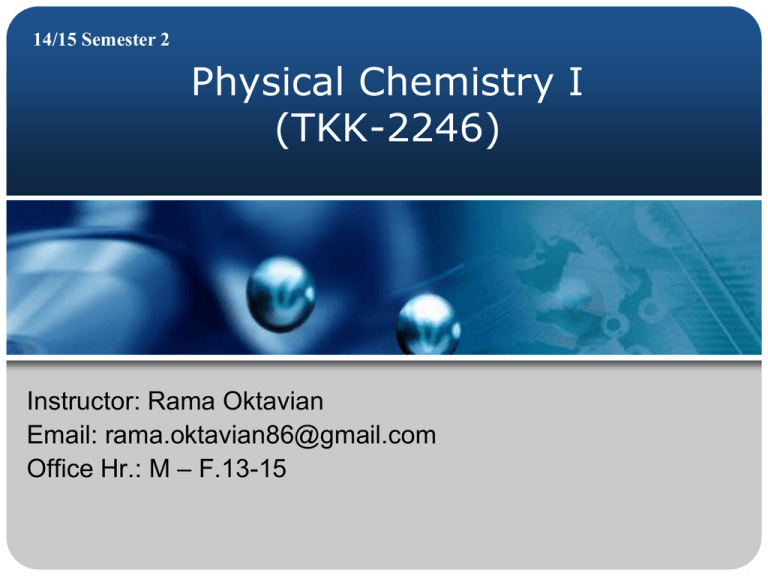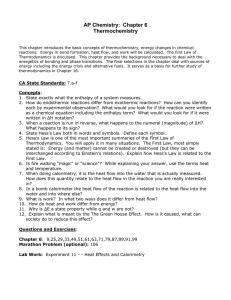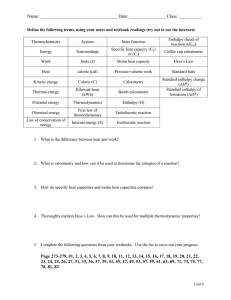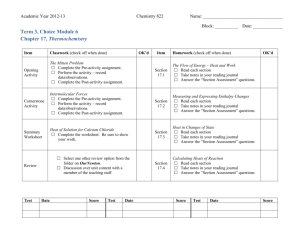
14/15 Semester 2
Physical Chemistry I
(TKK-2246)
Instructor: Rama Oktavian
Email: rama.oktavian86@gmail.com
Office Hr.: M – F.13-15
Outlines
1. Application of thermodynamics
2. Thermochemistry
3. Standard enthalpy change
4. Hess’ Law
Application of thermodynamics
Application of First law thermodynamic
In chemical reaction, temperature of system will change
heat of a reaction is the heat
withdrawn from the
surroundings in the
transformation of reactants at
T and p to products at the
same T and p
Exothermic : heat must flow to the surroundings to restore the system to the
initial temperature
Endothermic: heat must flow from the surroundings to restore the system to the
initial temperature
Application of thermodynamics
Exothermicity
– “out of” a system
Surroundings
Endothermicity
– “into” a system
Surroundings
Energy
System
q<0
Copyright © Houghton Mifflin Company.All rights reserved.
Energy
System
q>0
Application of thermodynamics
Example of chemical reaction
Consider reaction occurs in constant pressure and there are two steps of change
state
Application of thermodynamics
Example of chemical reaction
Step 1 - In the first step, reactants at T and p are transformed adiabatically to
products at T' and p
The temperature is change and pressure is constant. According to the first law of
thermodynamics
H Q
Since the process is adiabatic,
H1 0
Application of thermodynamics
Example of chemical reaction
Step 2 - the system is placed in a heat reservoir at the initial temperature T
The temperature is change and pressure is constant. According to the first law of
thermodynamics
H 2 Q
Application of thermodynamics
Example of chemical reaction
Heat of reaction can be calculated as
H H1 H 2 0 Q
H Q
Thermochemistry
Thermodynamics – Study of energy movement, relationship between heat,
work, and other energy forms
Thermochemistry – Study of heat absorbed or removed during chemical
reaction occurs
Heat of Reaction – The value of heat that is absorbed of removed during
reaction process at given temperature
A thermochemical equation is the chemical equation for a reaction
(including phase labels).
Thermochemistry
Calculating heat of reaction in different way
For any reaction
H H final H initial
Thermochemistry
Calculating heat of reaction in different way
For any reaction
Thermochemistry
Heat of formation H f
Example
Thermochemistry
Heat of formation H f
Example
Thermochemistry
Molar enthalpy of compound
Thermochemistry
Heat of formation
Thermochemistry
Heat of reaction
Heat of reaction calculation based on heat of formation
Standard enthalpy changes
Standard enthalpy change, ∆H0, the change in enthalpy for a process in which
the initial and final substances are in their standard states:
The standard state of a substance at a specified temperature is its pure form at
1 bar
the standard state of liquid ethanol at 298 K is pure liquid ethanol at 298 K and 1
bar
Standard enthalpy changes
Example of standard enthalpy changes
the standard enthalpy of vaporization
Standard enthalpy changes
Example of standard enthalpy changes
Standard enthalpy changes
Exercise
Problem 7.35 (a-i) from Castellan textbook
Hess’ law
“The standard enthalpy of an overall reaction is the sum of the standard
enthalpies of the individual reactions into which a reaction may be divided”
path-independence of the value of ∆rH0
Hess’ law
Example
Temperature dependence of
reaction enthalpies
Calculating heat of reaction at any reaction temperature
Differentiating with respect to temperature, we obtain
dH 0
C p0
By definition
dT
Temperature dependence of
reaction enthalpies
Calculating heat of reaction at any reaction temperature
Integrating,
Rearranging
Temperature dependence of
reaction enthalpies
Example
Re-Do example 7.6 from Castellan






